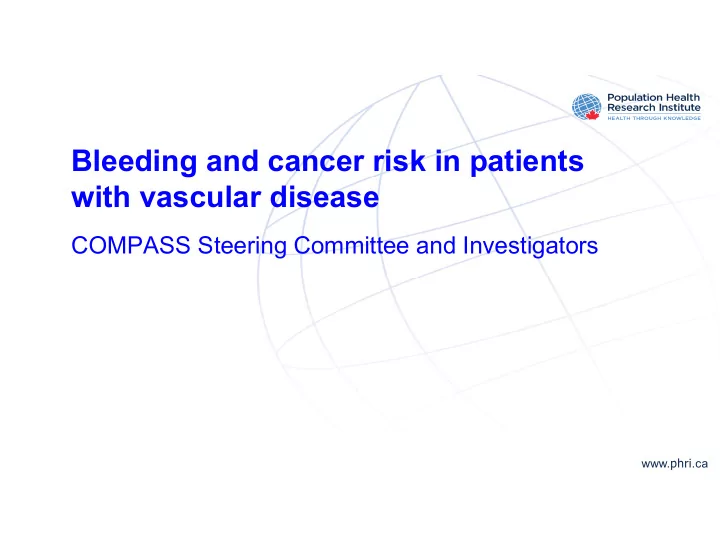

Bleeding and cancer risk in patients with vascular disease COMPASS Steering Committee and Investigators www. phri .ca
Background • Community studies have shown that gastrointestinal (GI) and genitourinary (GU) bleeding may be the first sign of underlying cancer 1,2 The COMPASS trial 3 demonstrated that rivaroxaban-based • treatments compared with aspirin increased GI bleeding • It is not known whether GI and GU bleeding during long- term antithrombotic therapy may unmask underlying GI and GU cancers, respectively 1. Jones R, et al. BMJ 2007; 334: 1040. 2. Ford AC, et al. Gut 2008; 57; 1545-52. www. phri .ca 3. Eikelboom JW, et al. N Engl J Med 2017; 377: 1319-30.
Hypothesis • In patients with vascular disease treated with antithrombotic drugs, GI and GU bleeding are associated with increased rates of new GI and GU cancer diagnosis www. phri .ca
Methods • COMPASS trial randomized 27,395 patients with stable CAD or PAD to receive rivaroxaban 2.5mg bid plus aspirin, rivaroxaban 5mg bid, or aspirin 100mg od • Major bleeding was defined according to the ISTH criteria (modified). Any bleeding not meeting the criteria for major was classified as minor • New cancer diagnosis (first-ever, or recurrent in patients with a history of cancer thought to have been eradicated) was recorded at each follow up visit www. phri .ca Bosch J, et al. Can J Cardiol 2017; 33: 1027-1035.
Analyses We examined: • The proportion of new cancers diagnosed before and after bleeding • The association between bleeding and new cancer diagnosis (using a stratified Cox proportional hazards model with bleeding modelled as a time-dependent covariate) • The rates of cancer diagnosis according to randomized treatment www. phri .ca
Number of new cancers and proportion diagnosed after bleeding New cancers Total number of new Site of diagnosed after bleeding cancers diagnosed cancer during COMPASS N % Any site 1,082* 257 23.8% Gastrointestinal 307 70 22.8% Genitourinary 138 62 44.9% Other sites 655 68 10.4% *Patients could have had more than one new cancer diagnosis www. phri .ca
Association between GI bleeding and GI cancer New GI cancers Total HR diagnosed (n=307) Population P value N (95% CI) N % GI bleeding After bleeding 901* 70 7.8 12.9 (9.77-17.0) <0.0001 No prior bleeding 27,395 237 0.9 Non-GI bleeding After bleeding 1,898* 29 1.5 1.77 0.004 (1.20-2.61) No prior bleeding 27,395 278 1.0 *Excludes patients with bleeding who were diagnosed with cancer before the bleeding event www. phri .ca
Association between GU bleeding and GU cancer New GU cancers Total HR diagnoses (n=138) Population P value N (95% CI) N % GU bleeding After bleeding 462* 62 13.4 83.4 (58.6-118.6) <0.0001 No prior bleeding 27,395 76 0.3 Non-GU bleeding After bleeding 2,301* 14 0.6 1.70 0.06 (0.97-2.99) No prior bleeding 27,395 124 0.5 *Excludes patients with bleeding who were diagnosed with cancer before the bleeding event www. phri .ca
Timing of cancer diagnosis in relation to bleeding Timing of GI and GU cancer diagnosis Within Between More than Site of cancer 6 months 6 and 12 months 12 months of bleed after bleed after bleed 54 6 10 Gastrointestinal (77.1%) (8.6%) (14.3%) 55 6 1 Genitourinary (88.7%) (9.7%) (1.6%) www. phri .ca
Frequency of GI bleeding in year 1, 2, and 3+ according to randomized treatment: landmark analysis Rivaroxaban 2.5mg bid Rivaroxaban Aspirin Year + ASA 100 mg od 5mg bid 100mg od N (%) N (%) N (%) 271/9,152 217/9,117 115/9,126 1 (3.0%) (2.4%) (1.3%) 74/7,760 85/7,748 59/7,823 2 (1.0%) (1.1%) (0.8%) 35/3,829 29/3,815 30/3,917 3+ (0.9%) (0.8%) (0.8%) www. phri .ca
Frequency of GI cancer after GI bleeding in year 1, 2 and 3+ Rivaroxaban 2.5mg bid Rivaroxaban Aspirin Year + ASA 100 mg od 5mg bid 100mg od N (%) N (%) N (%) 22/268 18/216 8/114 1 (8.2%) (8.3%) (7.0%) 6/72 6/81 5/58 2 (8.3%) (7.4%) (8.6%) 1/34 2/29 2/29 3+ (2.9%) (6.9%) (6.9%) www. phri .ca
Conclusions Among patients with vascular disease on long-term antithrombotic therapy: • More than 1 in 5 new diagnoses of cancer are preceded by bleeding • GI bleeding and GU bleeding are powerful predictors of new cancer diagnosis, and more than 50% are diagnosed within 6 months • Increased GI bleeding with rivaroxaban appears to unmask cancer at an earlier time point www. phri .ca
Implications • The occurrence of GI or GU bleeding in patients receiving antithrombotic drugs should stimulate a search for cancer in the same organ system • Extended follow-up of COMPASS trial participants may help to determine whether in vascular patients receiving long-term antithrombotic therapy, unmasking of cancer after bleeding improves cancer outcomes www. phri .ca
Acknowledgments COMPASS Steering Committee National Leaders Offices COMPASS Investigators COMPASS Trial Participants Bayer AG www. phri .ca
www. phri .ca
Cancer diagnosis by randomized treatment R+A R A Cancer (n=9,152) (n=9,117) (n=9,126) Total 366 (4.0%) 365 (4.0%) 351 (3.8%) GI 109 (1.2%) 111 (1.2%) 87 (1.0%) GU 47 (0.5%) 42 (0.5%) 49 (0.5%) GI or GU 155 (1.7%) 150 (1.6%) 136 (1.5%) Non-GI, non GU 216 (2.4%) 221 (2.4%) 218 (2.4%) www. phri .ca
Frequency of new GI cancer in year 1, 2, and 3+ post randomization according to randomized treatment Rivaroxaban 2.5mg bid Rivaroxaban Aspirin Year + ASA 100 mg od 5mg bid 100mg od N (%) N (%) N (%) 1 52 (0.6%) 52 (0.6%) 38 (0.4%) 2 41 (0.5%) 41 (0.5%) 30 (0.4%) 3+ 16 (0.4%) 18 (0.5%) 19 (0.5%) www. phri .ca
Recommend
More recommend